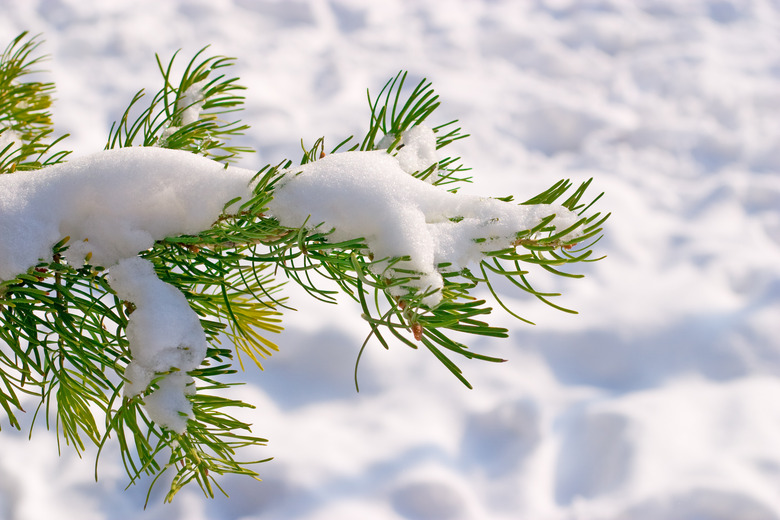How To Save Dying Spruce Trees
We may receive a commission on purchases made from links.
Whether you're growing Colorado blue spruce (Picea pungens) for its silvery blue foliage or white spruce (Picea glauca) as a wind screen, these rugged trees withstand frigid temperatures, but are finicky about the conditions they grow in. If they're not planted in the right conditions, spruce trees become susceptible to diseases or appear to be dying when they're not. Determining which is the case is the first step to saving your tree.
First, Diagnose the Issue
First, Diagnose the Issue
Some problems in spruces clear themselves up in time without help from you, but others need to be chemically treated. The first step in knowing whether your tree needs treatment or not is to determine what's ailing it. Inspect your tree and note what type of damage it has and where it occurs. For instance, note whether needles have turned purplish or brown and whether the damage is on one side of the tree, the lower branches, the upper branches, or the entire tree.
Properly Site a Spruce Tree
Properly Site a Spruce Tree
Spruce trees withstand extreme cold, but they don't like standing in waterlogged soil or having their branches whipped by strong, winter winds. Dry winds can cause winter burn, a nonfatal condition that turns needles brown, beginning at the tips, and is more common on the southwest or windward side of the tree. You can protect your tree from winter burn by planting one or two rows of wind-blocking trees on the prevailing wind side. To prevent overwatering your spruce tree, only give supplementary water when the top 3 inches of soil are dry.
Spruce Fungus Problems
Spruce Fungus Problems
Cytospora canker attacks Colorado blue and Norway (Picea abies) spruces, both hardy in U.S. Department of Agriculture zones 2 through 7. When you first see browning needles on lower branches, and bluish-white resin flowing from them, prune branches back to the next lateral branch at least 4 inches from the affected area. Prevent spreading the disease by spraying pruning tools with a household disinfectant and allowing it to dry between cuts. Left untreated, cytospora works its way up the tree, killing branches as it goes. It usually doesn't kill the tree, but does make it unsightly.
Spruce needle rust is a fungus that appears on the needle tips of white spruce, hardy in USDA zones 2 through 6, during cool, wet spring weather. Needles turn yellow in mid-summer with orange or white projections forming on them. Rust can infect the entire tree, but won't kill it, though affected needles fall off in the fall. They'll return in spring. Ensure that sprinklers aren't splashing on your tree to help stave off rust infections.
White Pine Weevil
White Pine Weevil
Spruce trees have shallow root systems and become stressed during drought, making them vulnerable to insect damage. White pine weevil attacks leader shoots in Norway spruce causing them to bend like a shepherd's hook and the needles to fall off. It's most common on trees less than 20 feet tall and is fatal to trees less than 4 feet tall.
Treat weevil problems by pruning away all dead tissue. Bag the pruned branches and dispose of them. Prevent spreading the problem by sterilizing your pruning shears with a household disinfectant after every 10 cuts.
Spruce Sawfly and Spruce Budworm
Spruce Sawfly and Spruce Budworm
Yellowheaded spruce sawfly and spruce budworm feed on new foliage on white, blue, and black (Picea mariana) spruce trees. Black spruce is hardy in USDA zones 3 through 6. Sawfly damage is seen from about mid-May through July. If left untreated, it can severely defoliate and kill a tree in three to four years.
Immature sawflies resemble a small green caterpillar with a yellow or reddish head. Spruce budworm resembles a brownish colored caterpillar, is about 1 inch long, and causes damage from about June through August. It chews needles and spins silk webs on the ends of tree branches, primarily in the tree crown. Left untreated, needles turn brown, and after three years, the tree crown dies. After about five years the entire tree dies.
Pest Control for Spruce Trees
Pest Control for Spruce Trees
When you first notice sawflies or budworms, mix 1 tablespoon insecticidal soap with 1 gallon of water to create a one percent solution. Spray affected areas until thoroughly coated during evening hours in addition to your routine care for your spruce trees. Repeat every five to seven days until the infestation is eliminated. Follow all instructions on the insecticidal soap label to ensure that it's safe for your tree and wear any protected gear mentioned, such as eye protection. For tall trees, hire a professional to safely treat the tree crown.
